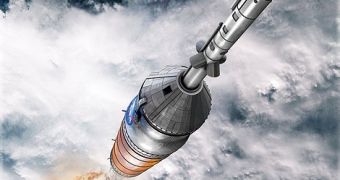NASA's latest version of moon craft, the very one who put its original designer, Michael Griffin, in the position of NASA administrator 3 years ago, has encountered new glitches. This would mean millions of dollars over the budget and a considerable lag in terms of deadline, but NASA is prepared to do anything to see the rocket lift off. The Ares I issues and the management approach of the agency have angered much of the personnel. Most of them would rather see the rocket not leaving the ground than give in to the compromises that would possibly help the craft reach the Moon.
Initially, it was discovered that Ares I didn't have the power to carry the crew into orbit, which was soon followed by the fact that the huge vibrations caused by the launching process would almost definitely kill the astronauts. The latest concern is related to the computer-simulated liftoff drift, which means that the engine ignition would push the 309 feet (94 meters) craft to the side, throwing it into the launch tower and destroying both. According to a NASA contractor, quoting a person involved in assessing the details of the problem, “As they incorporate more variables into the liftoff-drift-curve model, the worse the curve becomes.”
“If they push hard enough, yes, it will fly. But there are going to be so many compromises to be able to launch it, and it will be so expensive and so behind schedule, that it may be better if didn't fly at all,” states an Ares engineer. Currently, the grades that the rocket got from specialists for 10 criteria yield an average of 2.1, or a C minus. The agency even changed its standards related to safety and carriage, just to see Ares fly, which angered both astronauts and engineers, since their safety and time was their main concern. The glitches, say experts, result from the complex adaptations of the original design.
The outcome of the Ares I project will determine what happens to future U.S. manned space missions, as well as with the Kennedy Space Center. With all that, NASA officials, Griffin included, are surprisingly optimistic about it. “We have been doing design work and development the way it has always been done. I mean, this is among the very hardest things that human beings do, shared Griffin. There has never been an aerospace system developed without problems, and there likely never will be. In the end, NASA has always fixed them, and we will fix them this time.”

 14 DAY TRIAL //
14 DAY TRIAL //